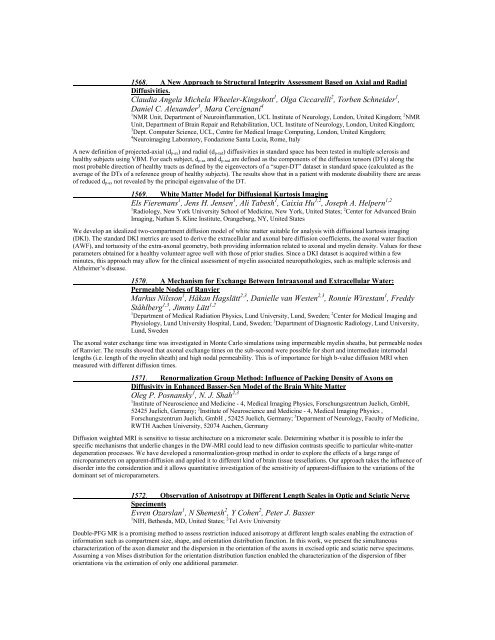Traditional Posters: Diffusion & Perfusion - ismrm
Traditional Posters: Diffusion & Perfusion - ismrm
Traditional Posters: Diffusion & Perfusion - ismrm
You also want an ePaper? Increase the reach of your titles
YUMPU automatically turns print PDFs into web optimized ePapers that Google loves.
1568. A New Approach to Structural Integrity Assessment Based on Axial and Radial<br />
Diffusivities.<br />
Claudia Angela Michela Wheeler-Kingshott 1 , Olga Ciccarelli 2 , Torben Schneider 1 ,<br />
Daniel C. Alexander 3 , Mara Cercignani 4<br />
1 NMR Unit, Department of Neuroinflammation, UCL Institute of Neurology, London, United Kingdom; 2 NMR<br />
Unit, Department of Brain Repair and Rehabilitation, UCL Institute of Neurology, London, United Kingdom;<br />
3 Dept. Computer Science, UCL, Centre for Medical Image Computing, London, United Kingdom;<br />
4 Neuroimaging Laboratory, Fondazione Santa Lucia, Rome, Italy<br />
A new definition of projected-axial (d p-ax ) and radial (d p-rad ) diffusivities in standard space has been tested in multiple sclerosis and<br />
healthy subjects using VBM. For each subject, d p-ax and d p-rad are defined as the components of the diffusion tensors (DTs) along the<br />
most probable direction of healthy tracts as defined by the eigenvectors of a “super-DT” dataset in standard space (calculated as the<br />
average of the DTs of a reference group of healthy subjects). The results show that in a patient with moderate disability there are areas<br />
of reduced d p-ax not revealed by the principal eigenvalue of the DT.<br />
1569. White Matter Model for <strong>Diffusion</strong>al Kurtosis Imaging<br />
Els Fieremans 1 , Jens H. Jensen 1 , Ali Tabesh 1 , Caixia Hu 1,2 , Joseph A. Helpern 1,2<br />
1 Radiology, New York University School of Medicine, New York, United States; 2 Center for Advanced Brain<br />
Imaging, Nathan S. Kline Institute, Orangeburg, NY, United States<br />
We develop an idealized two-compartment diffusion model of white matter suitable for analysis with diffusional kurtosis imaging<br />
(DKI). The standard DKI metrics are used to derive the extracellular and axonal bare diffusion coefficients, the axonal water fraction<br />
(AWF), and tortuosity of the extra-axonal geometry, both providing information related to axonal and myelin density. Values for these<br />
parameters obtained for a healthy volunteer agree well with those of prior studies. Since a DKI dataset is acquired within a few<br />
minutes, this approach may allow for the clinical assessment of myelin associated neuropathologies, such as multiple sclerosis and<br />
Alzheimer’s disease.<br />
1570. A Mechanism for Exchange Between Intraaxonal and Extracellular Water:<br />
Permeable Nodes of Ranvier<br />
Markus Nilsson 1 , Håkan Hagslätt 2,3 , Danielle van Westen 2,3 , Ronnie Wirestam 1 , Freddy<br />
Ståhlberg 1,3 , Jimmy Lätt 1,2<br />
1 Department of Medical Radiation Physics, Lund University, Lund, Sweden; 2 Center for Medical Imaging and<br />
Physiology, Lund University Hospital, Lund, Sweden; 3 Department of Diagnostic Radiology, Lund University,<br />
Lund, Sweden<br />
The axonal water exchange time was investigated in Monte Carlo simulations using impermeable myelin sheaths, but permeable nodes<br />
of Ranvier. The results showed that axonal exchange times on the sub-second were possible for short and intermediate internodal<br />
lengths (i.e. length of the myelin sheath) and high nodal permeability. This is of importance for high b-value diffusion MRI when<br />
measured with different diffusion times.<br />
1571. Renormalization Group Method: Influence of Packing Density of Axons on<br />
Diffusivity in Enhanced Basser-Sen Model of the Brain White Matter<br />
Oleg P. Posnansky 1 , N. J. Shah 2,3<br />
1 Institute of Neuroscience and Medicine - 4, Medical Imaging Physics, Forschungszentrum Juelich, GmbH,<br />
52425 Juelich, Germany; 2 Institute of Neuroscience and Medicine - 4, Medical Imaging Physics ,<br />
Forschungszentrum Juelich, GmbH , 52425 Juelich, Germany; 3 Deparment of Neurology, Faculty of Medicine,<br />
RWTH Aachen University, 52074 Aachen, Germany<br />
<strong>Diffusion</strong> weighted MRI is sensitive to tissue architecture on a micrometer scale. Determining whether it is possible to infer the<br />
specific mechanisms that underlie changes in the DW-MRI could lead to new diffusion contrasts specific to particular white-matter<br />
degeneration processes. We have developed a renormalization-group method in order to explore the effects of a large range of<br />
microparameters on apparent-diffusion and applied it to different kind of brain tissue tessellations. Our approach takes the influence of<br />
disorder into the consideration and it allows quantitative investigation of the sensitivity of apparent-diffusion to the variations of the<br />
dominant set of microparameters.<br />
1572. Observation of Anisotropy at Different Length Scales in Optic and Sciatic Nerve<br />
Speciments<br />
Evren Ozarslan 1 , N Shemesh 2 , Y Cohen 2 , Peter J. Basser<br />
1 NIH, Bethesda, MD, United States; 2 Tel Aviv University<br />
Double-PFG MR is a promising method to assess restriction induced anisotropy at different length scales enabling the extraction of<br />
information such as compartment size, shape, and orientation distribution function. In this work, we present the simultaneous<br />
characterization of the axon diameter and the dispersion in the orientation of the axons in excised optic and sciatic nerve specimens.<br />
Assuming a von Mises distribution for the orientation distribution function enabled the characterization of the dispersion of fiber<br />
orientations via the estimation of only one additional parameter.















